
Concept explainers
(a)
Interpretation:
The IUPAC name of the given molecule is to be written.
Concept introduction:
The root name of the molecule is the name of the
Answer to Problem A.46P
The IUPAC name of the given molecule is
Explanation of Solution
The given molecule is
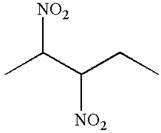
In this molecule, the longest continuous chain of carbon atoms has five carbon atoms. Hence, the root is pentane. The parent chain has two identical substituents; thus the chain is numbered so as to provide the lowest set of locants.
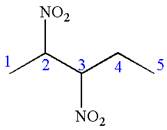
Hence, the IUPAC name is
The IUPAC name of the given molecule is written as
(b)
Interpretation:
The IUPAC name of the given molecule is to be written.
Concept introduction:
The root name of the molecule is the name of the alkane, which depends on the longest continuous chain of carbon atoms. The name of the substituent attached to the parent chain is written as a prefix to the left side of the root. The chain is numbered such that the carbon atom to which the substituent is attached gets the lowest possible number. This number is written on the left side of the substituent and separated by a hyphen. If more than one substituent is present, then the numbering is determined by the alphabetical order of substituents.
Answer to Problem A.46P
The IUPAC name of the given molecule is
Explanation of Solution
The given molecule is
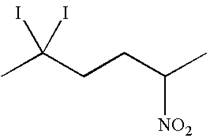
In this molecule, the longest continuous chain of carbon atoms has six carbon atoms. Hence, the root is hexane. The parent chain has three substituents; thus the chain is numbered so as to provide the lowest set of locants.
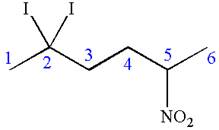
The substituents are arranged in an alphabetical order with respective locant.
Hence, the IUPAC name is
The IUPAC name of the given molecule is written as
(c)
Interpretation:
The IUPAC name of the given molecule is to be written.
Concept introduction:
The root name of the molecule is the name of the alkane, which depends on the longest continuous chain of carbon atoms. The name of the substituent attached to the parent chain is written as a prefix to the left side of the root. The chain is numbered such that the carbon atom to which the substituent is attached gets the lowest possible number. This number is written on the left side of the substituent and separated by a hyphen. If more than one substituent is present, then the numbering is determined by the alphabetical order of substituents.
Answer to Problem A.46P
The IUPAC name of the given molecule is
Explanation of Solution
The given molecule is
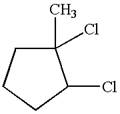
In this molecule, the five carbons ring is a parent. Hence, the root is cyclopentane. The ring has three substituents; thus, the ring is numbered so as to provide the lowest set of locants.
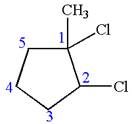
The substituents are arranged in alphabetical order with respective locant.
Hence, the IUPAC name is
The IUPAC name of the given molecule is written as
(d)
Interpretation:
The IUPAC name of the given molecule is to be written.
Concept introduction:
The root name of the molecule is the name of the alkane, which depends on the longest continuous chain of carbon atoms or the ring structure. The name of the substituent attached to the parent ring is written as a prefix to the left side of the root. The parent ring is numbered such that the carbon atom to which the substituent is attached gets the lowest possible number. This number is written on the left side of the substituent and separated by a hyphen. If more than one substituent is present, then the numbering is determined by the alphabetical order of substituents.
Answer to Problem A.46P
The IUPAC name of the given molecule is
Explanation of Solution
The given molecule is
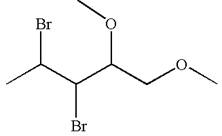
In this molecule, the five carbons ring is a parent. Hence, the root is cyclopentane. The parent chain has four substituents; thus, the chain is numbered so as to provide the lowest set of locants according to alphabetical order.
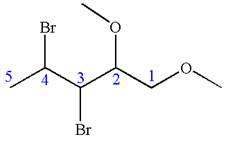
The substituents are arranged in alphabetical order with respective locant.
Hence, the IUPAC name is
The IUPAC name of the given molecule is written as
(e)
Interpretation:
The IUPAC name of the given molecule is to be written.
Concept introduction:
The root name of the molecule is the name of the alkane, which depends on the longest continuous chain of carbon atoms. The name of the substituent attached to the parent chain is written as a prefix to the left side of the root. The chain is numbered such that the carbon atom to which the substituent is attached gets the lowest possible number. This number is written on the left side of the substituent and separated by a hyphen. If more than one substituent is present, then the numbering is determined by the alphabetical order of substituents.
Answer to Problem A.46P
The IUPAC name of the given molecule is
Explanation of Solution
The given molecule is
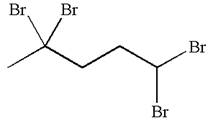
In this molecule, the five carbons ring is a parent. Hence, the root is cyclopentane. The parent chain has four identical substituents; thus, the chain is numbered so as to provide the lowest set of locants according to alphabetical order.
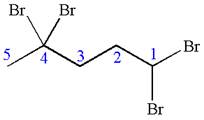
Hence, the IUPAC name is
The IUPAC name of the given molecule is written as
(f)
Interpretation:
The IUPAC name of the given molecule is to be written.
Concept introduction:
The root name of the molecule is the name of the alkane, which depends on the longest continuous chain of carbon atoms or the ring structure. The name of the substituent attached to the parent ring is written as a prefix to the left side of the root. The parent ring is numbered such that the carbon atom to which the substituent is attached gets the lowest possible number. This number is written on the left side of the substituent and separated by a hyphen. If more than one substituent is present, then the numbering is determined by the alphabetical order of substituents in a way to provide the lowest set of locants.
Answer to Problem A.46P
The IUPAC name of the given molecule is
Explanation of Solution
The given molecule is
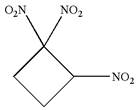
In this molecule, the four carbons ring is a parent. Hence, the root is cyclobutane. The ring has three identical substituents; thus, the ring is numbered so as to provide the lowest set of locants.
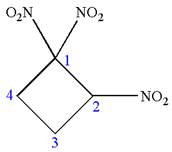
Hence, the IUPAC name is
The IUPAC name of the given molecule is written as
(g)
Interpretation:
The IUPAC name of the given molecule is to be written.
Concept introduction:
The root name of the molecule is the name of the alkane, which depends on the longest continuous chain of carbon atoms or the ring structure. The name of the substituent attached to the parent ring is written as a prefix to the left side of the root. The parent ring is numbered such that the carbon atom to which the substituent is attached gets the lowest possible number. This number is written on the left side of the substituent and separated by a hyphen. If more than one substituent is present, then the numbering is determined by the alphabetical order of substituents.
Answer to Problem A.46P
The IUPAC name of the given molecule is
Explanation of Solution
The given molecule is
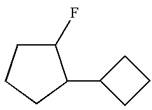
In this molecule, the five carbons ring is a parent. Hence, the root is cyclopentane. The ring has two substituents; thus, the ring is numbered so as to provide the lowest set of locants according to alphabetical order.
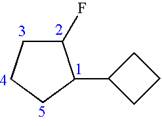
The substituents are arranged in alphabetical order with respective locant.
Hence, the IUPAC name is
The IUPAC name of the given molecule is written as
(h)
Interpretation:
The IUPAC name of the given molecule is to be written.
Concept introduction:
The root name of the molecule is the name of the alkane, which depends on the longest continuous chain of carbon atoms. The name of the substituent attached to the parent chain is written as a prefix to the left side of the root. The chain is numbered such that the carbon atom to which the substituent is attached gets the lowest possible number. This number is written on the left side of the substituent and separated by a hyphen. If more than one substituent is present, then the numbering is determined by the alphabetical order of substituents.
Answer to Problem A.46P
The IUPAC name of the given molecule is
Explanation of Solution
The given molecule is
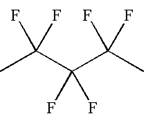
In this molecule, the longest continuous chain of carbon atoms has five carbon atoms. Hence, the root is pentane. The parent chain has six identical substituents; thus, the chain is numbered so as to provide the lowest set of locants.
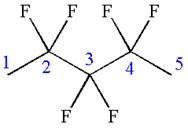
Hence, the IUPAC name is
The IUPAC name of the given molecule is written as
(i)
Interpretation:
The IUPAC name of the given molecule is to be written.
Concept introduction:
The root name of the molecule is the name of the alkane, which depends on the longest continuous chain of carbon atoms. The name of the substituent attached to the parent chain is written as a prefix to the left side of the root. The chain is numbered such that the carbon atom to which the substituent is attached gets the lowest possible number. This number is written on the left side of the substituent and separated by a hyphen. If more than one substituent is present, then the numbering is determined by the alphabetical order of substituents.
Answer to Problem A.46P
The IUPAC name of the given molecule is
Explanation of Solution
The given molecule is
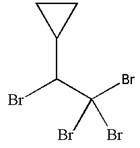
In this molecule, the longest continuous chain of carbon atoms has two carbon atoms. Hence, the root is ethane. The parent chain has five substituents; thus, the chain is numbered so as to provide the lowest set of locants.
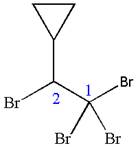
The substituents are arranged in alphabetical order with respective locant.
Hence, the IUPAC name is
The IUPAC name of the given molecule is written as
(j)
Interpretation:
The IUPAC name of the given molecule is to be written.
Concept introduction:
The root name of the molecule is the name of the alkane, which depends on the longest continuous chain of carbon atoms. The name of the substituent attached to the parent chain is written as a prefix to the left side of the root. The chain is numbered such that the carbon atom to which the substituent is attached gets the lowest possible number. This number is written on the left side of the substituent and separated by a hyphen. If more than one substituent is present, then the numbering is determined by the alphabetical order of substituents.
Answer to Problem A.46P
The IUPAC name of the given molecule is
Explanation of Solution
The given molecule is
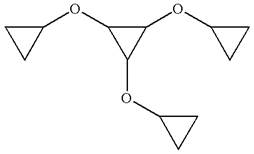
In this molecule, the middle ring of three carbons is a parent. Hence, the root is cyclopropane. The ring has three identical substituents.
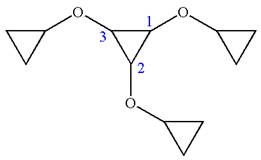
Hence, the IUPAC name is
The IUPAC name of the given molecule is written as
Want to see more full solutions like this?
Chapter A Solutions
Organic Chemistry: Principles And Mechanisms: Study Guide/solutions Manual (second)
- Predict the product of this organic reaction: IZ + HO i P+H₂O Specifically, in the drawing area below draw the skeletal ("line") structure of P. If there is no reasonable possibility for P, check the No answer box under the drawing area. No Answer Click and drag to start drawing a structure. ☐ :arrow_forwardPredict the products of this organic reaction: 0 O ----- A + KOH ? CH3-CH2-C-O-CH2-C-CH3 Specifically, in the drawing area below draw the condensed structure of the product, or products, of this reaction. (If there's more than one product, draw them in any arrangement you like, so long as they aren't touching.) If there aren't any products because this reaction won't happen, check the No reaction box under the drawing area. No reaction Click anywhere to draw the first atom of your structure. X ⑤ èarrow_forwardPredict the products of this organic reaction: O CH3 + H2O + HCI A A? CH3-CH2-C-N-CH3 Specifically, in the drawing area below draw the condensed structure of the product, or products, of this reaction. If there's more than one product, draw them in any arrangement you like, so long as they aren't touching. If there aren't any products because this reaction won't happen, check the No reaction box under the drawing area. No Reaction Click anywhere to draw the first atom of your structure.arrow_forward
- What is the missing reactant in this organic reaction? R+ HO-C-CH2-CH3 0= CH3 CH3 —CH, C−NH—CH CH3 + H₂O Specifically, in the drawing area below draw the condensed structure of R. If there is more than one reasonable answer, you can draw any one of them. If there is no reasonable answer, check the No answer box under the drawing area. Note for advanced students: you may assume no products other than those shown above are formed. No Answer Click anywhere to draw the first atom of your structure. €arrow_forward个 CHEM&131 9267 - $25 - Intro to Mail - Hutchison, Allison (Student x Aktiv Learnin https://app.aktiv.com Draw the product of the reaction shown below. Ignore inorganic byproducts. + Na2Cr2O7 Acetone, H2SO4 Type here to search Dryng OH W Prarrow_forwardPredict the products of this organic reaction: OH + NaOH A? Specifically, in the drawing area below draw the skeletal ("line") structure of the product, or products, of this reaction. (If there's more than one product, draw them in any arrangement you like, so long as they aren't touching.) If there aren't any products because this reaction won't happen, check the No reaction box under the drawing area. No reaction Click and drag to start drawing a structure. ✓ Sarrow_forward
- Predict the products of this organic reaction: CH3-C-O-CH2-CH2-C-CH3 + H₂O ? A Specifically, in the drawing area below draw the condensed structure of the product, or products, of this reaction. (If there's more than one product, draw them in any arrangement you like, so long as they aren't touching.) If there aren't any products because this reaction won't happen, check the No reaction box under the drawing area. No reaction Click anywhere to draw the first atom of your structure. :☐ darrow_forwardDE d. Draw an arrow pushing mechanism for the following IN O CI N fo 人 P Polle DELL prt sc home end ins F5 F6 F7 F8 F9 F10 F11 F12arrow_forwardPredict the products of this organic reaction: + H₂O H* ? A Specifically, in the drawing area below draw the skeletal ("line") structure of the product, or products, of this reaction. (If there's more than one product, draw them in any arrangement you like, so long as they aren't touching.) If there aren't any products because this reaction won't happen, check the No reaction box under the drawing area. No Reaction Click and drag to start drawing a structure.arrow_forward
- Predict the major organic products of the reaction below and draw them on right side of the arrow. If there will be no significant reaction, check the box below the drawing area instead. C Cl CH, OH There will be no significant reaction. + pyridine G Click and drag to start drawing a structure.arrow_forwardWhat is the missing reactant in this organic reaction? H R+ H2O Δ OH 0= CH3-CH-O-CH3 + CH3-C-OH Specifically, in the drawing area below draw the condensed structure of R. If there is more than one reasonable answer, you can draw any one of them. If there is no reasonable answer, check the No answer box under the drawing area. No Answer Click anywhere to draw the first atom of your structure. dyarrow_forwardYou are trying to determine whether the following organic reaction can be done in a single synthesis step. If so, add any missing reagents or conditions in the drawing area below. If it isn't possible to do this reaction in a single synthesis step, check the box below the drawing area instead. Note for advanced students: if you have a choice of reagents to add, you should choose the least reactive and most economical reagents possible. Cl It isn't possible to do this reaction in a single synthesis step. + T OHarrow_forward

 Organic And Biological ChemistryChemistryISBN:9781305081079Author:STOKER, H. Stephen (howard Stephen)Publisher:Cengage Learning,
Organic And Biological ChemistryChemistryISBN:9781305081079Author:STOKER, H. Stephen (howard Stephen)Publisher:Cengage Learning, General, Organic, and Biological ChemistryChemistryISBN:9781285853918Author:H. Stephen StokerPublisher:Cengage Learning
General, Organic, and Biological ChemistryChemistryISBN:9781285853918Author:H. Stephen StokerPublisher:Cengage Learning Chemistry by OpenStax (2015-05-04)ChemistryISBN:9781938168390Author:Klaus Theopold, Richard H Langley, Paul Flowers, William R. Robinson, Mark BlaserPublisher:OpenStax
Chemistry by OpenStax (2015-05-04)ChemistryISBN:9781938168390Author:Klaus Theopold, Richard H Langley, Paul Flowers, William R. Robinson, Mark BlaserPublisher:OpenStax



